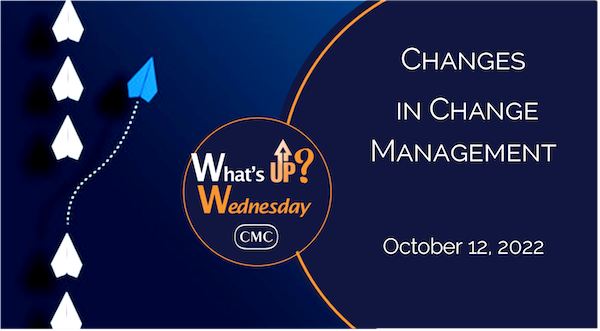By: CMC-Canada
In-conversation with Louise Harris
CMC-Ontario’s What’s Up Wednesday sessions provide thought leadership on the topics that matter to consultants. Join us virtually on October 12 for a great discussion on change management!
At the October What's up Wednesday, Dr. Louise Harris and Dr. Dawn-Marie Turner will discuss changes in change management. Our guest speakers are both PhDs, are sole proprietors of a change management practice, and hail from Newfoundland and British Columbia respectively.
To preview this upcoming session, we sat down with Dr. Louise Harris for her insights on change management:
--
What’s an example of a new trend in change management that leaders need to be aware of?
Agile Change Management is the most popular thread on the Association of Change Management Practitioner’s Global Connect discussion platform. Dive into the conversation and you will find many definitions of agile change management.
However, underneath all the discussion, blogs, and articles is the common, compelling need to make change happen faster and more often.
Organizational change is changing from being siloed events to being constant, multi-threaded occurrences. Managing multi-threaded change is complex and at times impossible.
This is why we are seeing increasing practical research into equipping and empowering people to collectively design organizational change rather than manage change driven from the top down.
What are some of the key characteristics of an effective change management program?
This is a dynamic question so there is not one answer. However, three common characteristics of an effective program are:
- Create clarity on the type of change – is it isolated, overlapping, or intertwined with other change?
- Create clarity on the expected outcomes of the change for the organization and impacted stakeholders, including employees
- Assess and mitigate the risk of key stakeholders not sufficiently adopting the change to achieve the outcomes
When outcomes and impacts are not clear, change is at best a muddle, and at worst, a disaster.
How has the pandemic impacted the work of change leaders?
In many organizations middle management and front-line staff were empowered to figure out what and how to change. There was no other option. They had to do it quickly, reflect, and learn from the results and change again.
You could refer to this as agile change. People felt empowered and trusted. They don’t want to go back to being told how to change by someone else who doesn’t really understand the detailed impacts of the change and doesn’t see the nuanced opportunities for improving the work experience. They want to be involved in figuring out how to change.
During the pandemic the outcomes were very clear – figure out how to communicate and share information with everyone working from home, figure out how to implement social distancing and other COVID protocols, figure out how to keep customers and interact with them online, figure out how to keep operations going with 30% of staff off sick or in isolation.
The consequences of not changing for many organizations were also clear – going out of business, more people getting sick, and people dying. Now, change leaders need to keep up with the expectations to provide clear and compelling outcomes.
Otherwise, if change muddles continue to occur, there will be faster and greater “quiet quitting” which will appear as change apathy or change resistance.
--
To learn more, Register for What's Up Wednesday: Changes in Change Management, October 12 TODAY!




